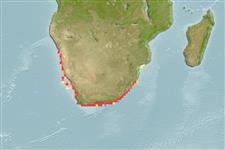>
Eupercaria/misc (Various families in series Eupercaria) >
Sparidae (Porgies)
Etymology: Chrysoblephus: Greek, chrysos = golden + Greek, blepo, blepharizo = to watch (Ref. 45335).
More on author: Valenciennes.
Environment: milieu / climate zone / depth range / distribution range
Ökologie
seewasser demersal; standorttreu; tiefenbereich 30 - 100 m. Subtropical; 22°S - 35°S
Western Indian Ocean: known only from South Africa.
Length at first maturity / Size / Gewicht / Alter
Maturity: Lm 36.5 range ? - 42 cm
Max length : 75.0 cm TL Männchen/unbestimmt; (Ref. 3198); common length : 40.0 cm TL Männchen/unbestimmt; (Ref. 3507); max. veröff. Gewicht: 7.3 kg (Ref. 40637)
Rückenflossenstacheln (insgesamt): 12; Rückenflossenweichstrahlen (insgesamt): 10; Afterflossenstacheln 3; Afterflossenweichstrahlen: 8
Found over rocky banks (Ref. 3198). Feeds on crustaceans, mollusks, worms, and small fishes. Seldom caught from the shore (Ref. 3198). Sold fresh in markets.
Also Ref. 28504.
Bauchot, M.-L. and M.M. Smith, 1984. Sparidae. In W. Fischer and G. Bianchi (eds.) FAO species identification sheets for fishery purposes. Western Indian Ocean (Fishing Area 51). volume 4. [var. pag.] FAO, Rome. (Ref. 3507)
IUCN Rote Liste Status (Ref. 130435)
Bedrohung für Menschen
Harmless
Nutzung durch Menschen
Fischereien: kommerziell; Sportfisch: ja
Mehr Information
ReferenzenAquakulturAquakultur ProfilZuchtlinienGenetikElectrophoresesVererbbarkeitKrankheitenVerarbeitungNutrientsMass conversion
PartnerBilderStamps, Coins Misc.LauteCiguateraGeschwindigkeitSchwimmstilKiemenoberflächeOtolithsGehirngrößeSehfähigkeit
Tools
Zusatzinformationen
Download XML
Internet Quellen
Estimates based on models
Preferred temperature (Ref.
123201): 13.7 - 23.8, mean 17.5 °C (based on 12 cells).
Phylogenetic diversity index (Ref.
82804): PD
50 = 0.5156 [Uniqueness, from 0.5 = low to 2.0 = high].
Bayesian length-weight: a=0.01698 (0.01029 - 0.02803), b=2.99 (2.85 - 3.13), in cm total length, based on LWR estimates for this species & Genus-body shape (Ref.
93245).
Trophic level (Ref.
69278): 3.7 ±0.54 se; based on food items.
Widerstandsfähigkeit (Ref.
120179): niedrig, Verdopplung der Population dauert 4,5 - 14 Jahre. (K=0.07).
Fishing Vulnerability (Ref.
59153): High to very high vulnerability (68 of 100).
Nutrients (Ref.
124155): Calcium = 51.1 [22.8, 91.4] mg/100g; Iron = 0.828 [0.442, 1.800] mg/100g; Protein = 19.1 [17.9, 20.3] %; Omega3 = 0.257 [0.144, 0.443] g/100g; Selenium = 31 [13, 73] μg/100g; VitaminA = 8.36 [1.75, 33.19] μg/100g; Zinc = 0.629 [0.411, 0.939] mg/100g (wet weight);
